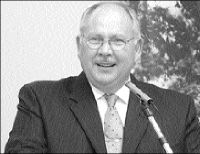
“Here Rests In Honored Glory An American Soldier Known But To God,” is the inscription carved onto the Tomb of the Unknowns at Arlington National Cemetery. The memorial has become one of the most sacred and visited sites in the Washington area since its inception after World War I.
The remains of an unknown Soldier from World War I were buried in a subterranean vault covered by a marble lid on November 11, 1921. The monument was not finished and topped off with a base, 50-ton die block — the largest, middle piece — and a capstone until 1932.
Eventually the remains of Soldiers from World War II, Korea and Vietnam were placed in the vault. The Vietnam War era remains were removed years later when DNA testing identified the person.
The cemetery superintendent John Metzler held a public meeting Monday evening at the cemetery’s visitors’ center to discuss plans to fix cracks in the Tomb. He told how cemetery officials first noticed chips in the marble in 1933 and how repairs were promptly made.
Primary and secondary horizontal cracks were reported in the 1960s and repairs were made with grout in 1975. In 1989 the cracks were cleaned and regrouted with a mixture of high lime and a polymer additive. No repairs have been attempted since then.
Metzler said the 50-ton piece of marble was originally quarried with dynamite to separate it from a mountain high in the Colorado Rockies and then tumbled end over end.
“The initial method probably led to damage,” he said. The superintendent also said modern techniques would use diamond saws and large lifts to more gently bring a block off the mountain.
Metzler said the cracks have increased since 1990 and he offered four alternatives. The first option is to do nothing.
The monument would continue to be degraded by weather and the cracks would grow. This alternative is not being seriously considered.
The second option is to repair the tomb. This would be a temporary and cosmetic fix and would not completely eradicate the problem cracks.
The third alternative is to conduct repairs, while procuring a replacement piece of marble and storing it for eventual use if and when the repair attempts fall short. This option would break the procurement process into two parts.
The first would be to find and purchase a suitable block of marble now. The second part would be to pay for the sculpting and installation at a possibly much later date. If the chosen block was found to have defects it may be impossible to find a replacement stone.
The fourth option would be to replace the monument’s base, die block and capstone. The approximately 55-ton die block would come from the home of original block, the Yule Quarry in Marble, Colorado. The quarry had closed from 1941 to 1990.
The marble block would first be transported to an artisan for the final finish and then transported to the cemetery, where it would take two weeks or so to exchange the new piece for the damaged marble.
The cemetery management believes the fourth option would be the proper one.
Metzler said a benefactor offered to donate the block when the quarry reopened and this option was still available. People have been leaving comments in a box in the visitors’ center and so far over 200 have been collected.
The public comment phase will end on August 6, 2006, and a decision will be made shortly thereafter. The old marble monument would remain in government control and possibly end up in the new Army museum, Metzler said.
Michael Robert Patterson was born in Arlington and is the son of a former officer of the US Army. So it was no wonder that sooner or later his interests drew him to American history and especially to American military history. Many of his articles can be found on renowned portals like the New York Times, Washingtonpost or Wikipedia.
Reviewed by: Michael Howard
